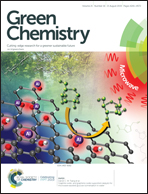Photocatalytic conversion of lignocellulosic biomass to valuable products†
Abstract
Biomass is a naturally abundant, sustainable and clean resource, which has potential to replace a portion of the finite petroleum and fossil feedstock for sustainable production of value-added chemicals and fuels. However, an efficient conversion process is still difficult to be achieved due to the complex nature of biomass. Currently, the simple, mild, and environmentally benign photocatalytic process appears to be a new research avenue for lignocellulosic biomass transformation. This review provides insights into the state-of-the-art accomplishments in photocatalytic conversion of lignocellulosic biomass and its derivatives, including selective cleavage of dominant bonds of lignin, valorization of processed and native lignin, photoreforming reactions of cellulose and its intermediates, and the depolymerization of robust native lignocellulose under visible or UVA light irradiation. In addition, electricity production from photocatalytic conversion of biomass is also discussed as an innovative lignocellulosic biomass transformation process. We then put forward perspectives for photocatalytic conversion of native lignocellulose and future challenges in increasing the profitability and sustainability of a photocatalysis biorefinery system.



 Please wait while we load your content...
Please wait while we load your content...